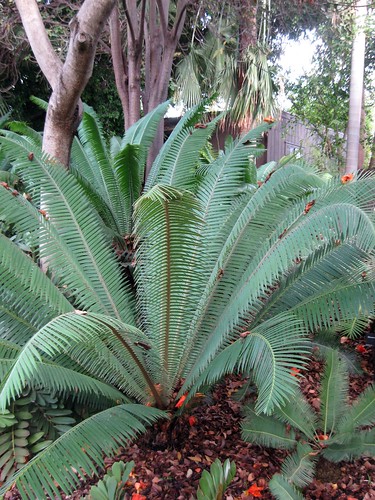Dioon mejiae is a plant I find so stunningly beautiful I find it hard to believe anyone could not want one in their home garden. Look at the apple green fronds and that perfect symmetry. Beautiful....and yet some people wouldn't even notice it or (worse) would write it off as a palm.

Cycads are apparently something that only certain people (people like me and perhaps you) find interesting or beautiful...and some of those people get a bit carried away. Check out this awesome article originally printed in NY Times Magazine about the addicts of the green needle. While we're on the subject note the amazing green colour these Dioon species have. It really is unique.
Of course plants have very different meanings to different people and in its native Honduras Dioon mejiae is known as Tiusinte and is appreciated not for its beauty but for its food value. Tiusinte provides food to "an estimated 33,000 indigenous and mestizo Hondurans. Female cones are harvested for their seeds, which are processed and made into tamales, tortillas, and other products. Leaves are used for a variety of Catholic celebrations and other minor uses of the leaves and female cone parts also persist." Tiusintes are being lost to agriculture and development but as a commmunity resource are subject to some communal protection (although of course the use of the seeds damages population recruitment). Hopefully Tiusinte tamales will be on the menu for thousands of years to come. For more on Dioon mejiae's ethnobotany check out this fascinating paper (wait a minute - tamales? scientific papers? I sound like Isis - what's next a shoe post?).
Of course plants have very different meanings to different people and in its native Honduras Dioon mejiae is known as Tiusinte and is appreciated not for its beauty but for its food value. Tiusinte provides food to "an estimated 33,000 indigenous and mestizo Hondurans. Female cones are harvested for their seeds, which are processed and made into tamales, tortillas, and other products. Leaves are used for a variety of Catholic celebrations and other minor uses of the leaves and female cone parts also persist." Tiusintes are being lost to agriculture and development but as a commmunity resource are subject to some communal protection (although of course the use of the seeds damages population recruitment). Hopefully Tiusinte tamales will be on the menu for thousands of years to come. For more on Dioon mejiae's ethnobotany check out this fascinating paper (wait a minute - tamales? scientific papers? I sound like Isis - what's next a shoe post?).
No comments:
Post a Comment